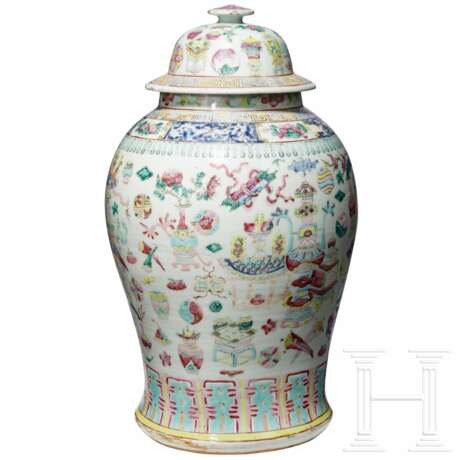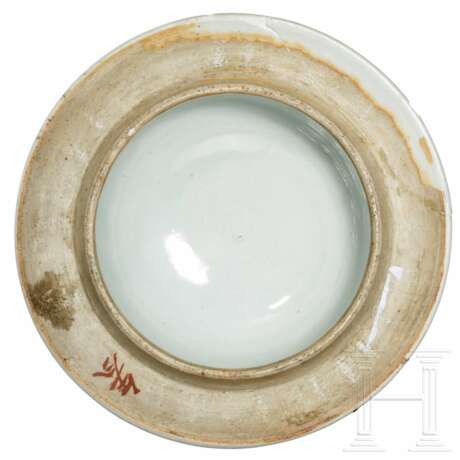ID 658774
Lot 624 | Große Famille-rose-Vase, späte Qing-Dynastie, 19. Jhdt.
Estimate value
€ 500
White glazed cup with everted rim, made of fine white porcelain and covered with transparent glaze. On the bottom within the footring the blue underglaze inscription: "Jinlu Dajiao Tan Yong" (= For use on the gold grand sacrificial altar). The "cha" (= tea) character in blue underglaze in the well of the cup. The mark is repeated in deep cobalt blue on the bottom. Probably Jiajing period (1522 - 1566) of the Ming Dynasty. Intact. No cracks. Light signs of use at the rim in the form of minimal glaze chippings. Height 4.9 cm. Diameter 9.2 cm. With old storage box.
This type of ceremonial cup is extremely rare. The "Taoshuo" and the "Jingdezhen Taolu" mention tanzhan (altar cups), small white cups inscribed with the characters for "tea", "wine", "hot water with dates", and "hot water with ginger", respectively. These Daoist ceremonial vessels were used by Emperor Jiajing. They don't have the same high quality as the cups from the Xuande period. These cups from the Jiajing period exist in three sizes: large, medium, and small. Those with the "tea" character are of good quality, while those inscribed ‘hot water with ginger’ are of inferior quality. They are inscribed "Jinlu Dajiao Tan Yong". In Daoist terminology Jinlu is an edict from the High Lord. The Jinlu dajiao (gold register), the huanglu dajiao (yellow register), and the yulu dajiao (jade register) are three important sacrificial ceremonies. The present cup (and excavated shards) provides important information as to what was placed on the altar on such occasions.
Provenance: South German private collection.
Condition: II
Äußerst seltene Tasse mit Inschrift "Jinlu Dajiao Tan Yong", wohl Jiajing-Zeit (1522 - 1566)
Weiß glasierte Tasse mit nach außen geschwungenem Rand, aus feinem weißen Porzellan und mit transparenter Glasur überzogen. Auf der Unterseite innerhalb des Fußrings folgende Inschrift in Unterglasurblau: "Jinlu Dajiao Tan Yong" (= Zur Verwendung auf dem goldenen Großopferaltar). Auf dem Boden der Innenseite das Zeichen "cha" (= Tee) in Unterglasurblau. Auf der Unterseite findet sich die Marke mit einem tiefen Kobalt-Blauton. Wahrscheinlich Jiajing-Periode (1522 - 1566) der Ming-Dynastie. Intakt. Keine Risse. Leichte Gebrauchsspuren am Rand in Form von minimalen Abplatzungen der Glasur. Höhe 4,9 cm. Durchmesser 9,2 cm. Mit alter Aufbewahrungsbox.
Diese Art von Zeremonialbechern ist extrem selten. Sowohl im Buch "Taoshuo" als auch im "Jingdezhen Taolu" werden Altartassen (tanzhan) erwähnt. Es handelt sich um kleine weiße Tassen, die mit den Schriftzeichen "Tee", "Wein", "heißes Wasser mit Datteln" bzw. "heißes Wasser mit Ingwer" beschriftet sind. Dies sind daoistische Zeremonialgefäße, die vom Kaiser Jiajing verwendet wurden. Sie sind nicht so herausragend in der Qualität wie jene aus der Xuande-Periode. Diese Tassen aus der Jiajing-Ära gibt es in drei Größen: groß, mittel und klein. Diejenigen mit der Aufschrift "Tee" sind von guter Qualität, während die mit der Aufschrift "Heißes Wasser mit Ingwer" minderwertig sind. Die Inschrift lautet "Jinlu Dajiao Tan Yong". In der daoistischen Terminologie ist Jinlu ein Erlass des Hohen Herrn. Die Jinlu dajiao (goldene Platte), die huanglu dajiao (gelbe Platte) und die yulu dajiao (Jadeplatte) sind Bezeichnungen für drei hohe Opferzeremonien. Der vorliegende Becher (und der ausgegrabene Scherben) liefert wichtige Informationen, was bei diesen Zeremonien auf die Altäre gestellt wurde.
Provenienz: Süddeutsche Privatsammlung.
Zustand: II
| Address of auction |
Hermann Historica Bretonischer Ring 3 85630 Grasbrunn / München Germany | ||||||||||||||
|---|---|---|---|---|---|---|---|---|---|---|---|---|---|---|---|
| Preview |
| ||||||||||||||
| Phone | +49 (0)89 5472 649 0 | ||||||||||||||
| Fax | +49 (0)89 5472 64999 | ||||||||||||||
| Buyer Premium | 25 % | ||||||||||||||
| Conditions of purchase | Conditions of purchase | ||||||||||||||
| Business hours | Business hours
|








